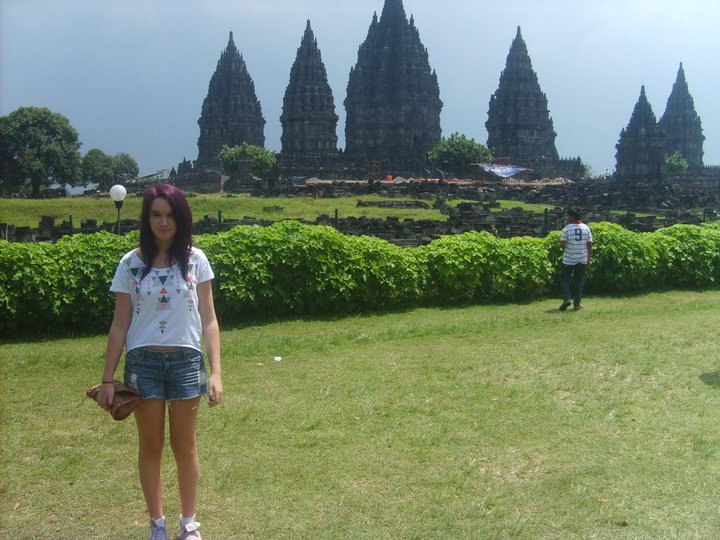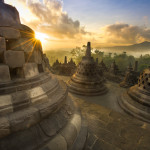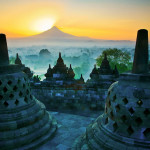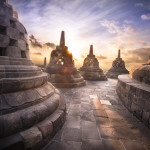Indonesia
The Many Buddhas of Borobudur
For as long as I could remember, my Dad had called Indonesia home. Yes, that meant that I didn’t see a whole lot of him when I got home from school, and no, he didn’t take me to the beach on weekends. So when we did have father-daughter outings, he occasionally made an attempt to make them particularly exceptional. As a child going shopping in Bali and Driving to Disneyland stood out as highlights, but the one holiday that stands out most as an adult is our trip to central Java, to admire Borobudur and the surrounding temples.
On this particular visit to Indonesia I had arrived with my tragic mid-teen-crisis blonde hair. My Dad lived in a town that was not home to many blondes, (I only saw one local with bleached hair during the entire visit), so I got my fair share of stares. I decided that I must be a brunette before we ventured went on our little trip. The local hairdresser obviously didn’t have much experience with the blonde-hair thing so I emerged from the salon with purple hair. It is safe to say I was getting just as many photos taken of me as the UNESCO world heritage site behind me in Borobudur.
Borobudur itself is a 9th-century Mahayana Buddhist Temple that floats above the lush-green Javanese landscape, ringed by volcanoes. It is the world’s largest Buddhist temple,as well as one of the greatest Buddhist monuments in the world.
Borobudur temple is a stone version of the Buddhist cosmos, starting in the everyday life and spiralling up to nirvana, the Buddhist heaven. The base of the monument features a series of reliefs, that represent a world dominated by passion and desire, where the good are rewarded as a reincarnation as a higher form of life and the evil are punished by becoming a lowlier reincarnation. These carvings are hidden by stone, but are partly viewable to the well-informed visitor.
Once you arrive you start at the main eastern gateway and make your way clockwise around the galleries of the Stupa. The sheer bulk of Borobudur is what makes it known to the world, but upon visiting the monument you will discover the most exquisite sculptural work. The pilgrim’s walk is about 5km long and you will pass hundreds upon hundreds of decorated panels, in which the sculptors have carved a virtual textbook of Buddhist doctrines as well as descriptions of life in Java a millennium ago.
But the star’s of this temple show are the buddha’s. All 432 serene-faced sculptures stare out from their open chambers above the galleries, while 72 more sit partly-visable in latticed stupas on the top three terraces, one being considered the lucky Buddha. The top platform is circular to represent never-ending nirvana.
There is no written record of who built Borobudur temple first, but it is believed that it was built between AD 780 and 840, when the Sailendra dynasty ruled the region. For centuries the temple was abandoned and buried beneath layers of volcanic ash from Mount Merapi, with only the local people aware of its existence.
 It wasn’t until 1814, when the British ruler of Java, appointed a team to investigate the ‘ancient monument’ on the hill that the locals spoke about. The discovery of Borobudur attracted worldwide attention but it took 21 years to fully clear the temple. Unfortunately, eight of containers full of the magnificent statues were given away to King Chulalongkorn of Siam during a visit to Indonesia in 1896. These missing relics are still on display in the National Museum of Bangkok today.
It wasn’t until 1814, when the British ruler of Java, appointed a team to investigate the ‘ancient monument’ on the hill that the locals spoke about. The discovery of Borobudur attracted worldwide attention but it took 21 years to fully clear the temple. Unfortunately, eight of containers full of the magnificent statues were given away to King Chulalongkorn of Siam during a visit to Indonesia in 1896. These missing relics are still on display in the National Museum of Bangkok today.
Not far from Borobudur, you can visit Prambanan Temple. Which is said to be the most beautiful Hindu temple in the world. It is the largest temple complex in Java, with three main temples dedicated to the three great Hindu divinities, Shiva, Vishnu and Brahma, the symbols of Trimurti in Hindu belief.
If you are visiting Java, the centre of the island is a real highlight and not to be missed, fly into Yogyakarta and you will find yourself on the doorstep of some of the worlds most magnificent temples. Few who visit these sights fail to be taken back by both the scale, and remarkable attention to detail of these magnificent structures. If you have any appreciation for aesthetically pleasing tourist attractions I doubt you will be the exception.
How to Get There
Borobudur is about 25 miles (40 kilometers) from Yogyakarta, where many day-trip tours can be booked. Those wishing to visit independently, or stay in Borobudur village outside the park entrance, can travel to the site by bus or taxi.
When to Visit
Though Borobudur teaches Buddhists to look inward, there are fantastic views from the temple over green fields and trees to distant hills and volcanoes—including active Merapi. Sunrise and sunset are particularly special times to be at the site. Weekends tend to be especially crowded.
How to Visit
Borobudur was designed to be climbed, and visitors able to follow the path of enlightenment to the top can experience the site as pilgrims did a thousand years ago. It’s well worth hiring a guide to explain the significance of statuary and the incredible bas-relief scenes along the way.













